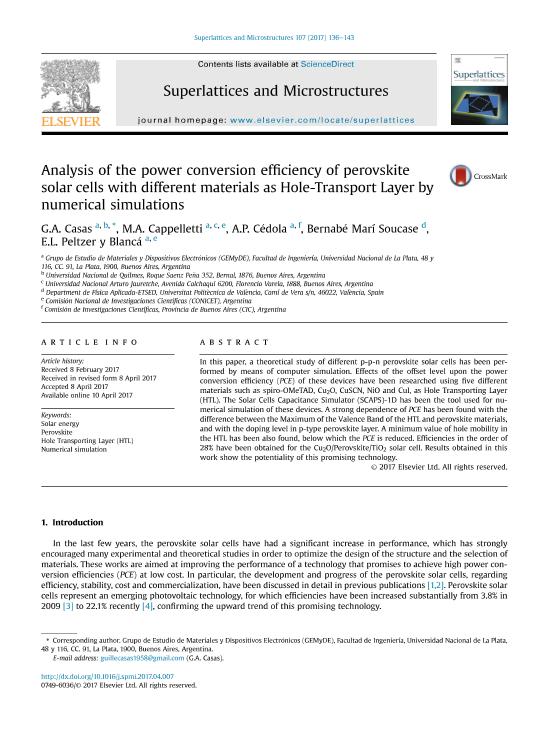Artículo
Analysis of the power conversion efficiency of perovskite solar cells with different materials as Hole-Transport Layer by numerical simulations
Casas, Adriana Gabriela ; Cappelletti, Marcelo Ángel
; Cappelletti, Marcelo Ángel ; Cedola, Ariel Pablo; Soucase, Bernabé Marí; Peltzer y Blanca, Eitel Leopoldo
; Cedola, Ariel Pablo; Soucase, Bernabé Marí; Peltzer y Blanca, Eitel Leopoldo
 ; Cappelletti, Marcelo Ángel
; Cappelletti, Marcelo Ángel ; Cedola, Ariel Pablo; Soucase, Bernabé Marí; Peltzer y Blanca, Eitel Leopoldo
; Cedola, Ariel Pablo; Soucase, Bernabé Marí; Peltzer y Blanca, Eitel Leopoldo
Fecha de publicación:
07/2017
Editorial:
Academic Press Ltd - Elsevier Science Ltd
Revista:
Superlattices And Microstructures
ISSN:
0749-6036
Idioma:
Inglés
Tipo de recurso:
Artículo publicado
Clasificación temática:
Resumen
In this paper, a theoretical study of different p-p-n perovskite solar cells has been performed by means of computer simulation. Effects of the offset level upon the power conversion efficiency (PCE) of these devices have been researched using five different materials such as spiro-OMeTAD, Cu2O, CuSCN, NiO and CuI, as Hole Transporting Layer (HTL). The Solar Cells Capacitance Simulator (SCAPS)-1D has been the tool used for numerical simulation of these devices. A strong dependence of PCE has been found with the difference between the Maximum of the Valence Band of the HTL and perovskite materials, and with the doping level in p-type perovskite layer. A minimum value of hole mobility in the HTL has been also found, below which the PCE is reduced. Efficiencies in the order of 28% have been obtained for the Cu2O/Perovskite/TiO2 solar cell. Results obtained in this work show the potentiality of this promising technology.
Archivos asociados
Licencia
Identificadores
Colecciones
Articulos(CCT - LA PLATA)
Articulos de CTRO.CIENTIFICO TECNOL.CONICET - LA PLATA
Articulos de CTRO.CIENTIFICO TECNOL.CONICET - LA PLATA
Citación
Casas, Adriana Gabriela; Cappelletti, Marcelo Ángel; Cedola, Ariel Pablo; Soucase, Bernabé Marí; Peltzer y Blanca, Eitel Leopoldo; Analysis of the power conversion efficiency of perovskite solar cells with different materials as Hole-Transport Layer by numerical simulations; Academic Press Ltd - Elsevier Science Ltd; Superlattices And Microstructures; 107; 7-2017; 136-143
Compartir
Altmétricas



